I'm narrowing down what I'm gonna stick my scope on. There is one more question I need to decide on the answer on before I proceed, unless I can get something real cheap. Do I stick with the scope I have, and move forward with just this, learn the skies properly, learn how to use a telescope, knowing that I will have limitations in magnifications, what a lot of other amateurs call low power, is high power for my little scope. Or, do I splash on a big light bucket which will gather a lot more light and allow higher magnification to be used with the eye pieces I already have. At the moment, I'm looking at:
an eq2, an az3 or the supatrak.
They are all available second hand, which will save some money, good with the CFO.
I haven't closed the door on something a lot more meaty mind you, but that's likely to put the cost up quite considerably and that might cause other problems...
Thursday 31 January 2008
Mount Update
30th Jan Observing and a mount update
A clear night for a while last night. Yippee thought I. Anyway, had some things to do during the early evening, and I kept anxiously gazing skywards to check that the stars were still there. Yes, each time, they were still there, no one had come along and swept them all from the heavens (probably for the best really). I got a brief 25 minutes early in the evening, and decided to just setup the camera and have a go at snapping Cassiopeia before she got to hide behind the trees.
Here's the picture, Cassiopeia naked...
21x13 seconds frames @ISO400 stakced in DSS and tinkered with in Photoshop Elements. I have no idea what the red mark is in the top left of the image...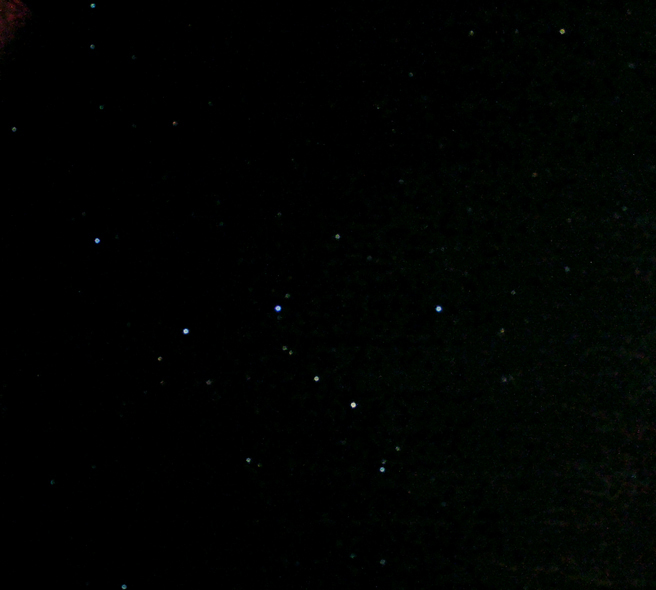
Went back indoors as I had some things to do (well, wanted to watch Torchwood if truth be told). Once Torchwood had finished, I grabbed my scope and the 10mm Plossl and dashed back outside. The sky was still clear. What's up, I thought, all evening, this is unusual. Anyway, I made the most of it. Had a look at M42, around Orion's belt, Sirius and on down to M41. Then decided to go find Saturn. I found Leo's question mark, and there hovering below was Saturn. Quickly found in the eyepiece and I spend some time just gazing. Then, thought I to myself, what the hell, lets try a quick experiment. Afocal Imaging. This is a lot easier to say than do. Especially when there is no way to attach the camera to the scope and you're trying to hand hold the camera, keeping the objective lens of the camera in the right area for the eyepiece image, not knock the scope, and try and keep track of Saturn in the eyepiece when the scope is on a normal static camera tripod. For some strange reason, I love a challenge. This is all made harder still, as the camera objective lens is about 35 mm, and the exit of the eyepiece on the scope about 5 mm. Not sure what the exit pupil of the optical train was. Still it worked and here is the result.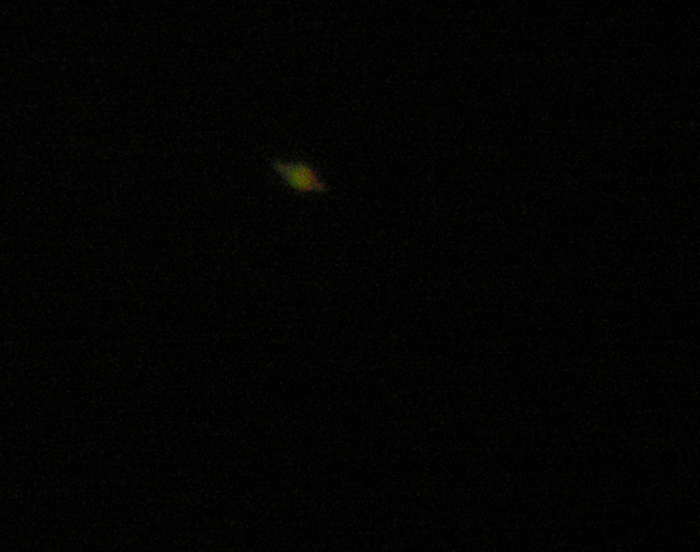
It's not a great image, and I'm sure if I knew how to use elements I could get a lot more out of it. In fact others already have, and I'm hoping they will whisper the secrets of this art to me...
Then the cloud pixies decided I'd had enough and a big bank of clouds rolled in blotting out the views of the stars. I hope they are all still there and didn't get washed away, but I can't tell now as it's still raining.
I thought I'd managed to solve the mounting dilemma, as I had found someone selling an eq2 mount, which would do fine for my little Konus on one of the forums, but it appears this is not to be. The current owner has responded saying he's in communication with someone else about it already and he would let me know. I think I'll have to move on and go back to the trying to second guess myself and my budget....
Wednesday 30 January 2008
On the (tripod) legs of the Mounting, Mounting Mountain Dilemma
To buy or not to buy, a replacement mount ? that is the question. Oh what to do. Mini EQ1, EQ2, EQ3/2, AZ3, Supatrak, Acuter Merlin, HEQ5, EQ6, CG4, Vixen GP, Witty One, HECQGE9.25764 Arrghhhh!. It's giving me bad dreams. I can hear the click, clickclick of the tripod feet chasing me down the street, they are all the same, yet all so different. Do I live with what I have at the moment, and suffer from not being able to track anything, and having to coax and jiggle the photo tripod head to get the scope to point where I want it to, on the grounds that I'm going to get a bucket of light collection (well nearly) at some point in the not too distant future, and get a mount with that ? Do I buy something and try and make it fit on the top of my camera tripod so that I can use that to track ? Do I just buy a full blown Astro mount and tripod ? New, second hand, old, borrowed, blue (hang on I did that some time back and it has nothing to do with Astronomy!!!).
I'm having nearly as much trouble with this as I was having before Christmas deciding what to invest my money in for a scope (until my other half found the Konus at half price and decided something had to be done).
I don't want to spend money buying something like the mini eq1 mount at full or near full price just to find that I can't easily mount it on top of my camera tripod, and it has to end up in the hands of Mr Hatchet and Bodge It to make it fit (I'll end up messing up badly and tossing the entire thing in the bin as my DIY skills are at best rubbish). As I'm intending to invest in a bigger scope, Newt of some sort, (possibly Dob maybe EQ mount), I don't really want to spend lots of money on a bigger mount (not that the CFO would approve anyway) when I haven't fully decided on what to go for, and any mount I bought now might not be man enough for the job. The Merlin Acuter mount would handle both my scope and my camera (although not at the same time) but isn't that cheap. There is a Supatrak mount available second hand for less, but I don't think I could mount my camera on it, and the scope would need to have money spent on it to fit it with a dovetail attachment of some sort (I think) so probably wouldn't be any cheaper. There's an AZ3 available also, about half price, but I think I'm back into the realms of having to buy more for the scope to get it on there, and I'm not sure the camera would fit. Or, I could buy a Nextar 60SLT from fleabay (if I can find one cheap enough), dispose of, in some way the 60mm scope that comes with it, and mount my Konus instead. I think this will also involve some improvement purchases to my current scope.
Ah well, Lets see what today brings, apart from, dare I say it, what looks like good weather ...
Tuesday 29 January 2008
Photo Update...
It's just been pointed out that in my Big Dipper photo, I appear to have caught the double (to be honest, I hadn't even realised there was one there, and thought either my camera had done something funny, or it was my image processing). I'm well chuffed with it now. The double in question is Mizar and Alcor and they the lowest bright star in the image (second from the right and straight on till morning, no wait .... where did that come from ?)
Jan 28th. Sky, wot sky ??
Took a look out last night, on lots of occasions, but the sky was covered in a blanket of fluffy looking stuff tinged with odd white and yellow patterns on the underside. Yes, I've obviously upset the cloud pixies again, by stating this blog. Ho Hum. So after watching University Challenge, and getting my world record number of correct answers, 5 right (four of those were on Astronomy).
1) In the celestial coordinate system, what is measured in Degrees, Minutes and Seconds - Right Ascension
2) What is the name of the globe of the sky with Earth at it's centre - Celestial Sphere
3) What is the name of the plane within the Celestial Sphere, where the planets and the Sun are found - Ecliptic
4) What is the name of the point when the equator crosses the plane of the ecliptic - Equinox
Yippee. Still Not enough answers correct to get close to the mrs but she is very good at Univesity Challenge.
I took the opportunity of the lack of clearness overhead to have a play with some of the images I took from previous nights and try and improve on them in Photoshop Elements. For improve, read learn how to use elements better. After playing for a couple of hours, and not really making any real improvements in the images (I doubt that's because there's no more information there ;o)), I still have no real clue what the hell I'm doing in elements. Although, I was able to repeat the removal of star trails from my Hyades picture, although even that took far too long to figure out what to do again, even with the instructions (I actually had to resort to using the Help facility). In the end, I closed elements and trashed everything I'd done in it. I think the ones posted below are about as good as I'm going to be able to get them for now and quite some time to come. This won't stop me keeping on playing, but the layers and levels stuff is all a bit confusing. I can't tell what layer is being shown me on the screen, nor what really happens when the image is flattened and all the layers disappear, as this then appears to just be what was on screen. So much to learn to this photo processing.
Monday 28 January 2008
Update 27th Jan Session
Thanks very much to a friendly neighbourhood forum member, I have confirmation that I saw moons around Saturn, and in fact they were Titan to the left, and Tethys to the lower right.
For others, here's a link provided to me, that shows the Saturn system
http://www.skyandtelescope.com/observing/objects/javascript/saturn_moons#
Observing session 27th Jan
Another clear night, must be a record ;o). Was quite surprised (not sure why though) as the forecast was for cloud. Tried to pop out early evening, was going to try a star trails photo. I checked, clear skies, popped into get the camera setup on the tripod (all of 2 minutes), popped back and guess what. Blinking clouds everywhere. I slink back indoors and put it all away again. Oh well thinks I, that'll be it then. I kept checking the satellite photos on the metoffice website and it look like it ought to be good. A couple of hours later, I checked, and yipee, no clouds. Now, I dashed around, adding layer upon layer (it was cold and I needed to) gathering my stuff together and out I went. Beautifully clear and cold. Excellent. I setup the camera for star trails. The usual self timer etc. about a minute later, it turned itself off. Damn it through I. Flat batteries (I hadn't changed them/recharged them) from a couple of nights before. Popped inside for some more, trying not to look at anything vaguely bright and using my red torch, nearly worked too. Plugged them into the camera, turned it on, and I don't believe it, they are flat also. Back for the third time. This time success. I got a fully charged set. Set it all up again. Waited for the self timer to count down, the usual message about pressing the shutter button to stop the exposure popped up, so I turned around to setup the scope. Looked back after a moment or two and the camera was off. That's odd I thought to myself and went to check. It turned on ok, no battery warning. Tried again. And again just over a minute later, it turned off. Checked the camera settings. It turns itself off after one minute. Blast. Checked the settings, maximum timout is 10 minutes. That's no good I'd hope to use the batteries up completely doing this. None of the previous attempts had captured anything, as when the camera turned off, it didn't save, only discarded. Ah well, gave up on that idea.
I finally got the scope up and running and had a look at M42 for a while, always a nice view. Moved up to belt and had a good long look at Collinder 70, then carried on up to Orion's head for Collinder 69 around Meissa. Decided I try again to find M41 and M50 had a look again at TL@O and this time guessed correctly the distance to shift the scope from Siruius.
A quick side note. After my efforts the other night, I sought some advice and was recommended to get a minus violet filter to remove the CA. This arrived Saturday morning and got a try out tonight. I used Sirius, as the moon was in hiding. Only when the scope was quite a way out of focus could I see evidence of purpe around the edges, so this filter seems to do it's job really well. Test's during the day, Saturday, showed a yellow hint to the view, but this wasn't noticeable looking at the stars.
Back to the night sky. Having guessed the correct distance, up popped M50. Had a look at this cluster. Then decided, that as my luck was in and I was on a roll to try again, and this time I got M41. Excellent, thought I and spent a while looking at this cluster also.
I moved onto Saturn, lurking around the side of the house. This time I didn't use such hgh magnification, which gave me a longer window of viewing before having to jiggle the photo tripod. I'm pretty certain that after a few minutes of viewing, that I saw a couple of Saturn's moons. One off to the left (or right or some direction, I get muddled by which direction is which in the ep) and one lower right. Even better than the previous session, and now I knew what to look for (others have been posting images) I may have seen a slight shadow around the ring system too.
I figured I'd have another go at a couple of constellations with the camera and opted for the Big Dipper and Gemini. I had intended to try for Cassiopeia, but by this time, she'd got a little low in the sky for my garden and was hiding in the upper branches of a tree.
Here's the images:
Big Dipper : 8x15 Seconds at ISO400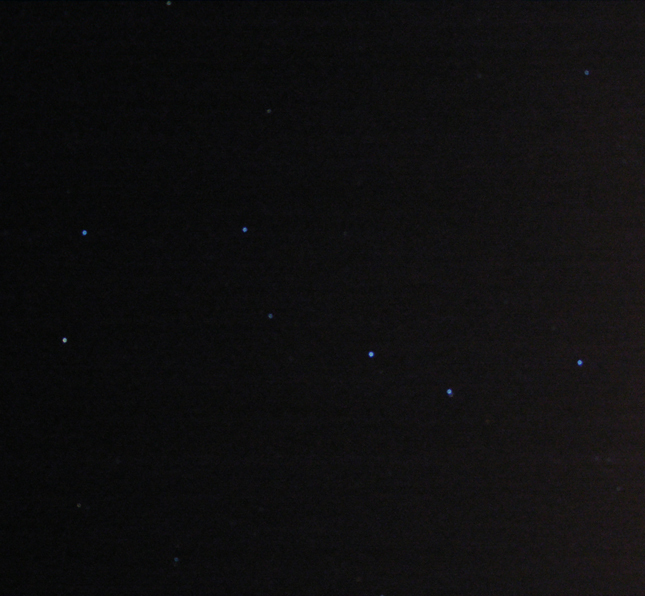
Gemini : 20x15 Seconds at ISO400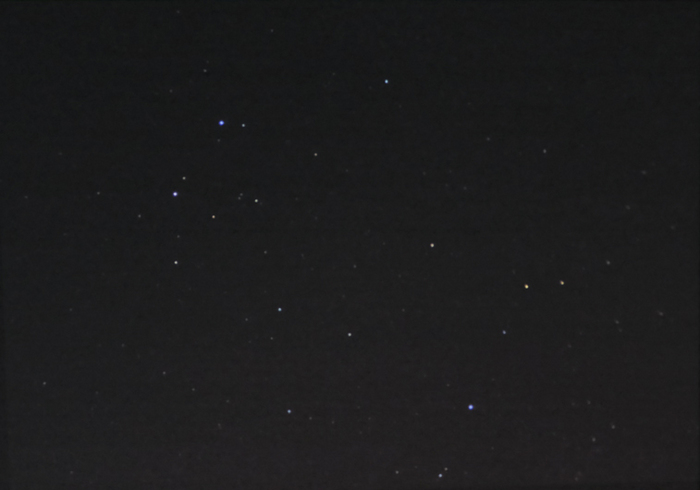
Whilst I was taking the Gemini images, I had a good look at Sirius and Beetlegeuse. Then moved onto M45 and watched this awhile (I like doing this, such a nice cluster). Whilst I was snapping away and looking at M45, a really odd thing happened, and it puzzled me for a while. I've understood that the more you look the more you see. So it was really odd to see the Pleiades dimming slowly. There was no sign of any fogging on my lenses, nor clouds up above. I took another few shots of Gemini whilst I pondered on this little conundrum. I'd noticed that it felt considerably colder than it had earlier in the evening. I decided to have a look round, and there was the reason. Rolling in from the west was a thick layer of fog, and I was in the outer edges. At that point I gave up and packed away. Spent a while warming up and allowing the lenses to unfog from being taken into the house, and whilst this was happening worked on stacking and processing the images.
Another enjoyable night under the stars. Looking forward to the next time the cloud pixies decide to give us a break, but looking at the window now as I write this, it doesn't look like it's going to be today.
Observing session 24th Jan
A nice and clear night, first one in a while, so I was all eager to get outside with the scope and have a hunt. I checked on Stellarium for the location and time to rise for Saturn, not seen this yet and wanted to give it a try. I decided I'd setup the camera on a tripod as well and see about getting a couple of stacked widefield images whilst I was at it. The moon was near full, but was hiding behind my house, which meant the garden was reasonably dark. Even with a scope this size, that can be carried in one end, all set, there was still quite a lot to carry out. The scope, the camera, two chairs, the case with the ep's etc in, a notebook, pen, planishphere, Turn Left at Orion (TL@O), and last months Sky at Night magazine (well, really still this months, but as next months is out already). Anyway, got all setup, and I thought I'd start with the usual favourites. M45. Spent quite a few minutes just staring at this in the 20mm ep, with the sisters nearly filling the FOV. Moved onto M42 and spent a while more there. Then I remembered Saturn. Move the scope so I could see past the house, lined up with the RDF, dropped in the 5mm Ortho lens, and pop. There it was. And what a Sight. Even in my little scope at 80x I could see Saturn really clearly. I popped in the x2 barlow, cranked up to 120x and even more WOW!!!!. I ran to the house, and called inside that I could see Saturn and the rings. My wife came out and had a look too. I think she was impressed, first time with my new hobby, always a good thing. She went back inside as she wasn't really dressed for it. Next thing I know, my kids came outside to have a look to. They had just gone to bed, but she thought they'd like to see. I got a chair so they could look into the ep and they had a good long look at 120x, then I send them packing, as it's MY telescope and I wanted a look ;o). Spent some time looking at Saturn, only gave up in the end as with that level of magnification, Saturn only stayed in the eyepiece for about 30 seconds, and the camera tripod, whilst pretty sturdy and good, doesn't have the fine tuning necessary to track. Note to self, must sort out something better as a mount.
Anyway, after looking at Saturn, I decided to see what I could do with my camera. I set it up for full manual operation and attempted to focus, in the end I gave up and set it at infinity and left it there. After a couple of test shots, I was lined up for Orion. So I snapped away, setting the self timer after each shot (no remote shutter release). I also shot the Hyades and the Pleiades.
Orion - 15 frames of 15 seconds at ISO400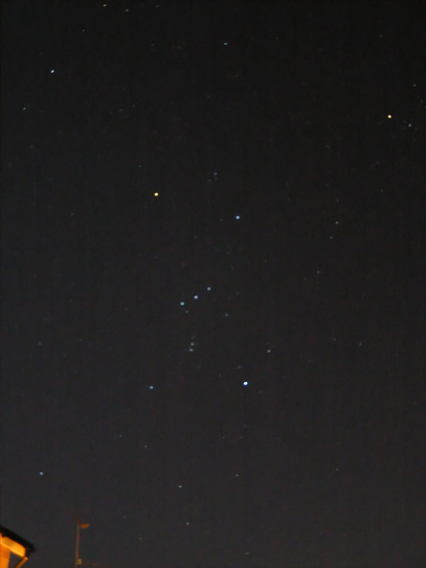
Hyades - 10 frames of 15 seconds at ISO400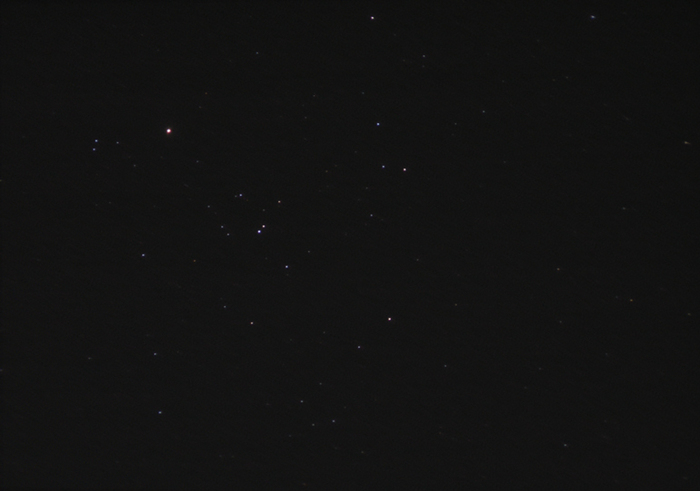
This one had some star trails, I forgot to reduce the exposure time when I zoomed in, but some help from a Forum, gave me the tricks to use to remove them.
Pleiades - 18 frames of 3.2 seconds at ISO400 (10x zoom)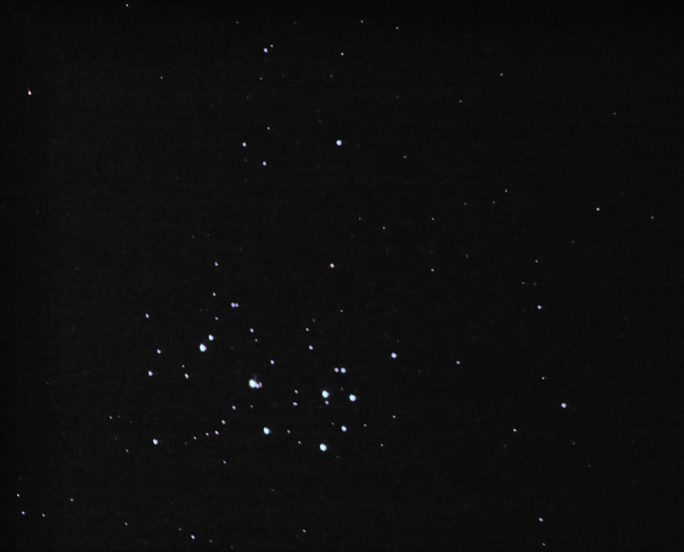
Having taken these sequences of shots, my camera started complaining about the batteries. So I gave up on the photos and went back to the scope. Using TL@O I decided to see if my scope could split any double stars. Firstly Beta Monoceros, this worked fine, definatly saw two stars there. Moved onto Castor, and again saw two, but I'm pretty certain this is the (AB) and C pair only, not the really tight paring of A and B). I hunted around for a while for M81 and M82, I think I may have found them, but I don't think I can get enough magnification in this scope to be able to see them clearly. I tried for M1, M41 and M50, but I didn't see them. Then hunted for NGC457, and found that, and the Double in Perseus.
Then moved onto the Moon as it had decided now was a good time to show it's face over the top of the House. I took a long look at the moon, although it took awhile for the green glow across my vision to fade after the first glance. It was now that I discovered the Chromatic Abberation (CA) in my little scope. It didn't seem to be affecting the view too much as I could see craters and hills and stuff on the moon (no idea which ones mind you). After a further 30 minutes of looking at the moon, I gave up for the night and headed indoors. Unable to see properly in one eye as I'd switched on the lights, and the other eye because of the afterimage of the moon. But hey, I'd enjoyed myself immensely.
I spent a long time playing with the images, staking, restaking, tinkering and tweaking to get to the images above. I think it was worth it.
Observing session 7th January
I had a nice clear night last night, which surprised me somewhat, given the weather in the afternoon and the forecasts, but thought I, I'm not going to look a gift horse in the mouth. I got out about 2100 last night, and was surprised, that even with my little scope, I ended up having to make a couple of journeys. A couple of chairs, the maplin flight case with my ep's in, Turn left at Orion and a notebook and a red torch, which in true Blue Peter style I'd prepared earlier.
I started out just looking at a couple of the favourites in wide field. The Pleiades and M42 in Orion. Nice a crisp pinpoints on the Pleiades. I thought I'd try a little experiment on M42 and upped the power in use a couple of times (my barlow arrived yesterday morning). Oh boy was I glad I did this, suddenly the, what I can only describe as "wings" of the Nebula, opened up before my eyes... WOW!!!! I spent quite sometime just staring into the ep and then realised that M43 was in the same place (having checked Turn Left at Orion).... It was then I discovered my first mistake... My nice red torch, that I'd made, was still too bright... Looking back in the scope, my first thought was that I must have knocked it as the "wings" were no longer so visible, then I realised I'd blown my night vision with the red torch (Damn !!!!). Need to rethink the torch idea. However, once my eyes had settled down again, I think I was able to catch M43 there also. As an attempt to use the, not so bright idea (yet too bright to use) torch, I used the non viewing eye on the book and found that, in theory I ought to be able to see some of the stars at Sigma Orionis. I took a long hard look, and reckon I was just about able to get A and E. Still not bad with my little scope I reckon.
Now I found my second mistake of the night. I wanted to go and find new objects, but as I hadn't planne anything, I was having trouble working out where to go next. I spent some time looking through TL@O to find objects in the same area. I settled on trying to find M44 the Beehive cluster and after some searching, I was able to locate it. I did find I tended to move the scope in the wrong direction, which made star hopping a little tricky, but I'm sure I'll get used to this moving things with an upside down view eventually. I had a look at Castor on the very slim off chance I might be able to split it, but I wasn't holding out any hope based on Sigma Orionis, and I was correct in my assumptions. Not a chance.
I had a quick look at Mars and using the barlow, got up to 120x and was able to make out a small disk (better than the small blob the other day!!).
I moved around some more and went searching for M81 and M82. Here again my inability to track the scope in an upside down way hampered me a lot and after searching for about 45 minutes I gave up, I'll return here again and keep looking, but at this point I noticed my toes were beginning to feel like lumps of ice and figured this was a sign I ought to be heading indoors to thaw out. Still I thought to myself, a few more minutes won't hurt (much). I went back to the Pleiades and M42 for another 5 minutes, had a quick scan around Cassiopeia and picked up NGC663 into the bargain, then headed indoors for a hot drink.
All in all, a successful couple of hours, although, in hindsight, a dimmer torch and a bit of forethought and planning what to look for is in order for the next time the pixies decide to grace my area with clear skies.
First Proper session with the scope 5th Jan 2008
Finally, after what has seemed like weeks or months since Christmas, I looked out the window last night at about 2100 to discover that the clouds had parted and made way for some nice clear skies. Well, I quickly grabbed a fleece, coat and a pair of boots a chair and my little Konus and got out there. First thing, the Konus is mounted on a 30 year old camera tripod, so I wasn't quite sure how much wobble I was gonna get. All in all, the tripod did quite a good job at damping vibrations, even using the 6.5 ep on Mars, the focus wobble was suppressed in about 3 seconds so it's working well.
I went for the usual suspects to get a test on the scope. So I kicked off with the Pleiades. A really nice view through the 20mm ep. Then I had a look at Andromeda M31 for a while, and I could see a little more fuzz than with my bins. I then swung around and had a look at Mars. I could see a tiny little ball with the 6.5mm ep. Whilst there was no detail, it was still a WOW!! I saw the first bit of CA on Mars also, but only when I wasn't lined up on the ep properly.
Then, as I was in the area, I had a look at M35, M36 and M38. It was here I discovered that the finder scope had become misaligned whilst I was using it (the tube and mountings are all plastic), I have an RDF on order from FLO but it's not arrived yet. Still, I gave up with finder, and sighted by eye and wandered till I found what I was looking for after this.
I found m42 and had a good long look at this. Nice white cloud. I spent quite some time looking here as this is the first time I've seen so much of it. The scope, despite its aperture not being that much bigger than my bins, just grabs that much more light.
I then moved on, passing Mirfak and having a look at the association, it just fitted in the 20mm ep. Took me a while to figure out that I had found it, as I'd forgotten that it was reveresed in the ep of a scope DOH!!!
I went from here to the double cluster, and had a good long look with the 20mm ep. It was here I discovered the differences in the ep's that were delivered with the scope, and the ep's I bought from second hand. No contest, the Konus ep's are plossls, but they just don't provide the same views...
I then just meandered along the Milky Way, marveling at the sheer numbers of pin points of light that the scope was able to show me that the bins didn't.
Now, I may have done this in the wrong order, but I remembered, as the cold was beginning to seep into my toes, about something called a star test. So I lined up the scope on Polaris, and defocused both in an out. I couldn't detect any abnormalities in the blur that showed up on either side, so I guess this means the optics are reasonable. I tried this with both the 20 and 6.5mm ep's. I then had a look at the engagemnt ring, back to the Pleaides for a final look, and ran for warmth.
All in all a really enjoyable nights viewing, and nice to be able to give the scope a workout.
Christmas Present 2007
For Christmas, I received my first Telescope. It's a little short tube refractor sold as Konus. I believe that it's made by Synta and is the same as the Skywatcher ST80. Some details. It's an 80mm objective refractor with a 400mm focal length. The finder that came with it, is a tad useless, just removing the lens caps are enough to knock the alignment out. I replaced it with a red dot finder (Baader Skysurfer III) and this is much better. I've also invested in a few second hand eye pieces and a barlow. Here are a couple of pics.
Setup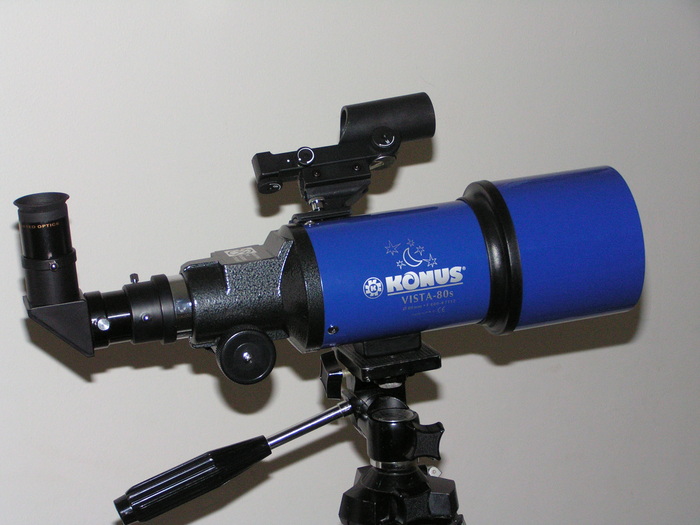
Packed in a Maplins Flight Case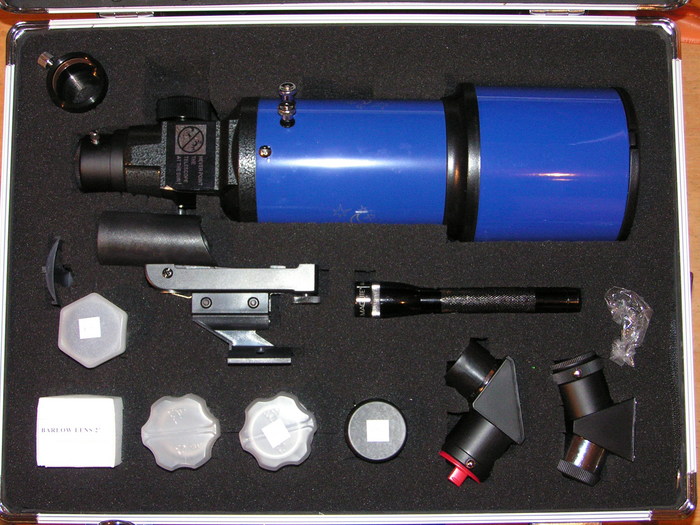
In the case now (a couple of minor changes) I have
Plossls : 32mm, 20mm, 10mm, 6.5mm
Ortho : 5mm
Barlow : Tal x2
One 90 degree mirror diagonal (Cheap and plasticky, soon to be replaced)
One 45 degree prism diagonal (as supplied, but better quality)
One 30 mm extension tube (now with new and improved attached Fringe Killer)
One modded AA maglight (it's now red)
Baader Skysurfer III red dot finger
An odd green thingy that I think is supposed to be a moon filter. Tried it once and it really didn't help. Not sure why it's still there, guess I just haven't got around to tossing it out yet.
Being able to get all this in the case, means that when I go camping etc, I can take it all with me and should it ever stop raining (it always rains when I go camping, so I will apologise now to whichever Astronomers are in the area when I next go).
And a brief first light (29th December 2007) :
Finally had a chance to get it outdoors just now as the clouds have cleared up and our nearest neighbour is hovering there. The scope came with a rather flimsy feeling 5x24 finder on a plastic finder mount, all of which twists and turns when removing and replacing the caps, but I was able to allign it and use it. The scope came with a 17mm and 10mm Plossl, I'm not sure how good they are, but I was able to get clear view of the moon through both of them with little evidence of purple fringing (or maybe that's just me eyes ![]() ). With the 10mm, giving 40x view, I was able to see quite some detail on the surface and the moon nearly filled the FOV. It seems to me that this is a good little scope, will make a great grab 'n go scope, seeing as it will also fit in the Maplins flight case it'll be good for taking on holiday, and give's me something to use, that still has a reasonable field of view as a step between the Bin's and a reflector.
). With the 10mm, giving 40x view, I was able to see quite some detail on the surface and the moon nearly filled the FOV. It seems to me that this is a good little scope, will make a great grab 'n go scope, seeing as it will also fit in the Maplins flight case it'll be good for taking on holiday, and give's me something to use, that still has a reasonable field of view as a step between the Bin's and a reflector.
My First Reports (using Binoculars)
Friday 30th November
I managed to get out with the Binos for about 45 minutes last night. Had a good look around, but couldn't identify most of what I saw, although it was very spectacular. I was able to find and identify
NGC869 - Double Cluster
M31 - Nebula in Andromeda
M42 - Nebula in Orion (I think I was just about able to see some whispiness, but I can't be sure as I'm not certain what to expect to see)
Mars (that was easy...)
Comet Holmes, it's got a lot dimmer in a very short space of time
And probably the best so far
NGC1432 - Pleiades. Very small, but brilliant view.
Saturday 1st December
I was finally able to figure out where the constellation Auriga was on Saturday night, and using the guide, was, just about able to, find M36, M37 and M38 using averted vision. I was well chuffed.
Friday 7th December
Tonight is the first proper clear night in a about a week here and I made it outside for nearly an hour. I started by managing to get some lovely blobs on my digicam of the Pleiades, it's got a 10X optical zoom lens, so figured it would be pretty close to my Binos for FOV, but I just can't seem to get the thing to focus. Never mind. So I had a good long look instead. I then moved on to Comet Holmes, still very visible if dimmer. Had a brief wander around to practice finding object to look at, and found a few items quite easily without having to refer to Stellarium. I found the Andromeda Galaxy, M36 and M38 in Auriga and a look at Mars. After that, and a quick referral to Stellarium, I found 35 and M103. I may have managed to spot the California Nebula, but I'm really not sure, although I'm pretty certain I was looking in the right place. I had a good long look at the Pleiades again, I must confess that the sisters are turning into one my favourite at the moment. At this point, I had a bit of a shock  , as some pilot decided to fly his rather large passenger plane through my FOV . After that onto the Orion Nebula, I can definitely see more there now than I could a few weeks ago when I first started. I tried to find M78, but I don't think I managed that, then had a quick look at Polaris to see if I could find the "Engagement Ring" and I was amazed how easy it was to pick up. At that point, my fingers decided that was enough (I'd forgotten to put my gloves on
, as some pilot decided to fly his rather large passenger plane through my FOV . After that onto the Orion Nebula, I can definitely see more there now than I could a few weeks ago when I first started. I tried to find M78, but I don't think I managed that, then had a quick look at Polaris to see if I could find the "Engagement Ring" and I was amazed how easy it was to pick up. At that point, my fingers decided that was enough (I'd forgotten to put my gloves on ![]()
![]() )
)
Nevertheless, Despite the chilled fingers, I'm feeling quite pleased, that after only about a month of looking, I'm now learning my way around and find some DSO's. The Bino's were a great investment and thanks to all those who wrote that on the forums.
Lets get going
I've decided to jump on the Blog-wagon and use this site to post my Astro observation logs and links to any photos that I take. I'll see where this takes me. The obvious place to state I guess is at the beginning. Back in March last year, I decided to try and take some images of the total lunar eclipse. At that point, despite having had my camera (Minolta Z2) for nearly three years, I hadn't really got to grips with it, and truth be told, even now I still haven't, so the three or four images I took were not in focus and the images are not great. Then some months later as I was helping someone out with a little project, that required looking at the moon through a pair of binoculars (at this point a pair of 8x35) I was amazed at how much more of the surface could be seen. As I was coming up on my 15th year of employment with the same company, I decided I'd use my anniversary aware to purchase me a telescope. I started looking for review etc, and joined a couple of forums. Here I discovered that the best start was to not leap in and buy a scope, but to invest in a pair of at least 10x50 binoculars. This I did (actually going for 12x50) and found to my amazement, the total buzz that looking up at what you think you can see, and discovering that there is just so much more there. And even greater, finding objects that are so far away and so dim, that you just can't see them with your eyes, yet through the binoculars look so spectacular. Anyway enough for now. I'll be back later, with my initial observing reports, using the Binoculars, and more details on where I'm at now (a whole 3 months later ;o)).






